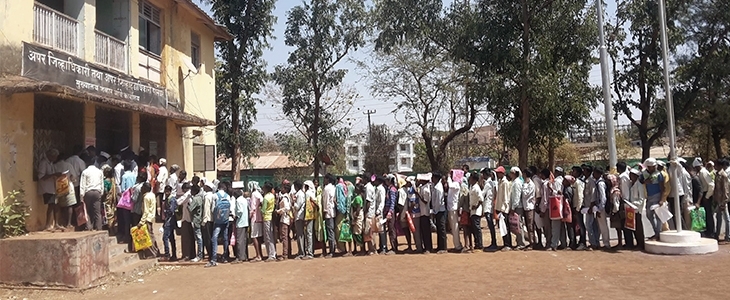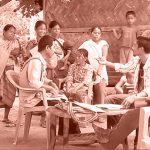
Bridging gaps between citizens and the bureaucracy – Part 1
30 June 2017
This is the seventh part of an eight-part series on the challenges and life hacks in experiencing and accessing government benefits and services.
Since the last two months we have been sharing stories of common citizens who attempted to avail rightfully owed benefits and services with varying degrees of success. Each story is set in a unique context but a couple of common issues unite these experiences. In this blog I will discuss two themes that kept emerging in the previous posts and how these affect both citizens and bureaucrats.
Issue 1: Digital illiteracy in Digital India
Public services are being digitised across all states in India. Telecommunication networks are expanding and internet connectivity is improving but digital literacy is still in its infancy. Even if people have the access and skills to navigate the internet, they may still feel stuck because text on many of the government websites is in English and not in regional languages.
In one of our blogs about water woes in Delhi, we learnt that in the absence of knowledge around how to access or apply for a drinking water pipeline, locals invariably turned to local politicians. All the information, however, is available on the Delhi Jal Board website, but the locals were not computer literate nor did they have ready access to internet facilities. In my blog, I shared the story of a man who also happened to be computer illiterate and had no access to necessary resources to access services. In his struggle to get his daughter admitted to a private school under the Economically Weaker Section quota, he ended up relying heavily on his employer’s goodwill to help him get critical information at all stages, apply for admissions and also lodge his grievance – all done online.
Among other issues raised in the blog on challenges around the effective implementation of Aadhaar in a village in rural Madhya Pradesh, the rise of technically sound middle-men who charge a small fee to ‘help’ out village folk was a major one. They make use of these intermediaries when they need to access or update their registered online information.
The cost of digital illiteracy is partially borne by bureaucrats themselves. Officers spend a disproportionate amount of time dealing with the public on a daily basis over petty matters.
The cost of digital illiteracy is partially borne by bureaucrats themselves. Officers spend a disproportionate amount of time dealing with the public on a daily basis over petty matters. This could be easily resolved if citizens are digitally literate and the content on these websites is available in regional languages. This would free up bureaucrats’ time and allow them to focus on their core tasks, and also directly address the next issue.
Issue 2: Grief around grievance redressal
Are grievance redressal mechanisms just an added layer of bureaucracy which must be tackled before one is to access services or benefits? This is one question that the reader may be left with after reading the blogs in this series.
We describe how a man from Bihar ended up organising a protest to grab the Department’s attention to the issue of the people who were not getting their due rations under the Public Distribution System. He and his compatriots took this extreme step after the Department officials continued to ignore their formal complaint which was lodged earlier with the Food & Consumer Protection Wing. Their efforts bore fruit but raised questions around the efficacy of having the grievance redressal wing in the first place.
Back in Delhi, calling on the Delhi Jal Board helpline and lodging formal complaints with the Department to access drinking water pipelines prove to be a dead-end for the area’s locals. Water tankers continued to provide water in this area and that too of substandard quality (this was a stop gap arrangement made by the efforts of their MLA, according to the locals). After repeated attempts at seeking redress, the locals seem to have accepted this as their fate.
In a third instance, the Education Department in Delhi set up its grievance redressal portal for issues around EWS admissions (portal is entirely in English though). The applicant got a response within a week’s time which was very helpful. But one doesn’t know if the speed with which the government responded was an indicator of the Department’s general efficiency and rate of responsiveness or to the fact that education (and admissions under the EWS quota in particular) is an area of political focus.
When a query is filed under the RTI Act, the inquirer gets a time-bound response because departments are legally bound by the Act. This is not the case with most grievance redressal mechanisms.
In another blog we explored how important the Right to Information Act has become to get the state to respond to citizen’s queries. A man filed RTI applications upon pre-empting an issue in his area. The state responded within 30 days as it is legally bound to do so under the Act. There was backlash against his RTI ‘activism’ but he ultimately got the right officials to address the problem before it escalated.
When a query is filed under the RTI Act, the inquirer gets a time-bound response because departments are legally bound by the Act. This is not the case with most grievance redressal mechanisms. The draft of the Right of Citizens for Time Bound Delivery of Goods and Services and Redressal of their Grievances Bill, 2011 continues to languish in Parliament. The status and efficacy of various state level grievance redressal mechanisms can and should be questioned. The time is ripe to carry out research into how complaints submitted on various grievance redressal portals are processed, and where the bottlenecks lie.
In part two of this blog (and the last one in this series), we will sum up the “hacks” applied by the protagonists in this series, and way forward to address the issues discussed above.





